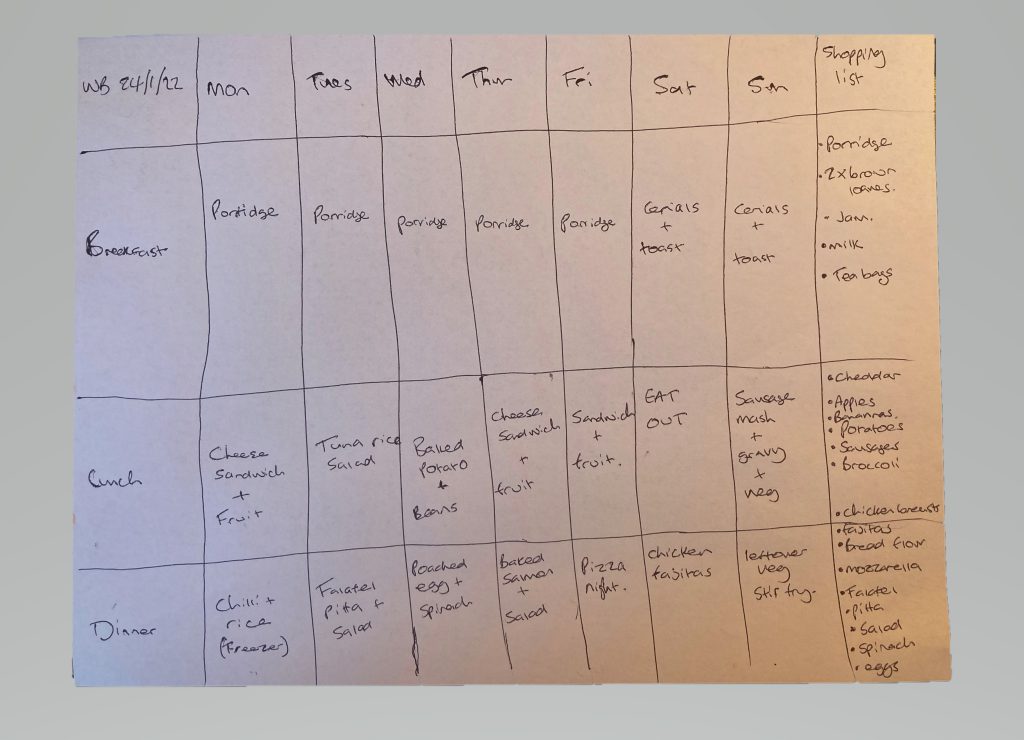Love Food Hate Waste Meal planning and using shopping lists
Love Food Hate Waste say there are two leading causes which account for nearly 70% food waste in our homes, they are:
- Not using food in time – we don’t get around to eating it before it becomes inedible
- Changes in personal preference – we change our minds and choose to eat something else instead
Meal planning and using shopping lists tackle these two causes of food waste, and they are proven to be effective in most homes. They tend to be most effective when done together, and when they are done regularly.
Did you know…a fringe benefit of meal planning is that it also helps you keep track of your diet. A 2017 study into meal planning habits in Europe found that people who planned meals in advance – even occasionally – had a more varied and nutritionally balanced diet, and they were less likely to be overweight or obese.
It’s worth setting aside a short period of time to meal plan and write a shopping list because it’s a really good way to get a snapshot of how food is being used and wasted in your household.
For now, read our guide to effective meal planning and make a start when you are ready.
Meal planning guide
Do some preparation:
Before you start jotting down meals and listing things to buy, think about how often you shop for food, how much time your meal plan or shopping list is going to cover, how many people you are planning for or with, and what your budget is.
The majority of people in the UK shop for food weekly at a single supermarket. If this is what you do, it probably make sense to plan a week’s worth of meals and one long shopping list. If you tend to shop more or less frequently, find yourself doing top up shops, shop at more than one place, or two or more people go on separate shopping trips, you’ll need to incorporate all that in the way you meal plan and how you create and use your shopping list(s).
Give yourself enough time to meal plan and write a shopping list properly. Aim to do it before you next go food shopping, but not too far in advance (or your plans might change in the meantime).
A basic meal plan and shopping list can be put together in half an hour or less if you have a good idea of what you want to eat and what you already have at home.
Tip – List your favourite meals before you plan anything. Ask your family to help to build a list of their favourite meals. Include breakfast, main meals and side dishes, desserts and snacks. Don’t forget packed lunches / picnic type meals. Keep this list and add to it over time. You can use it as inspiration to populate your meal plan(s) in the future and help speed up the process.
Time to plan:
Meal plan at the same time as writing your shopping list.
You could use a simple grid on a piece of paper, print a free template from the internet, use a white/blackboard in your kitchen, or make use of an app (see below).
If more than one person shops for food then shared shopping list apps can be helpful or sticking your meal plan to your fridge might make it easier for others in your household to follow it.

Meal planning apps
There are hundreds of meal planning apps available. Those listed below may include optional paid for content but the basic functionality is free (at the time of writing):
- Yummly (app store and Google play)
- Mealboard (app store)
- Plan to eat (Google play) (app store)
- Mealime (app store and Google play)
- Forks plant based meal plan (Google play) (app store)
- Meal planner Pal (app store)
- Meal Planner – plan your meals for the whole week (Google play)
- Big Oven (Google play)
Stocktake as you go
Check your food cupboards, fridge and freezer and base meal plans around what foods you already have. Set out your meal plan so you’ll use up any foods about to ‘go off’ early in the week / before they become inedible or past their best. If you don’t know the difference between use by and best before dates, now is a great time to brush up your knowledge.
Use by dates – used for safety reasons and food should not be consumed after that date.
Best before dates – used to describe quality and food should still be safe to consume after the date has passed.
Check your calendar
Double check with your family to see how many people will be attending each meal. Knowing how many people will be eating (and how much they are likely to eat) helps you to buy, prepare / cook and serve just the right amount of food. Estimate or consult a recipe to find out and write down the quantities you’ll need to buy on your shopping list – this helps you to avoid under or overbuying once you are in the shop. If you aren’t sure how much you need to buy, for example because you are cooking for a larger number of people than usual, you can use a portion calculator.
Build in some flexibility
Allow for days when you’ll be short on time or likely won’t fancy cooking. If you bulk-cook and then freeze meals you’ll need to plan in days when you eat those quick meals.
Plan meals that share common ingredients
For example, minced beef could make homemade burgers one day, bolognese sauce the following day, and if you have excess perhaps a chilli to be frozen and eaten next week. Doing this means that you’ll likely end up with a logical chain of meals that all share one or more common ingredient. You don’t have to eat them all in one week – freeze some.
Take your shopping list with you to the shop
It’s no good if you find yourself at the shop and realise your shopping list is still stuck on your fridge. If you have a smartphone, it can help to take a quick photo of your list immediately after writing it so it’ll be with you in the shop.
Stick to your shopping list
The whole point of meal planning is to help you avoid buying more food than you need, so avoid the temptation to add a few extras here and there, especially if you are sticking to a budget.
Don’t forget the freezer
You can bulk cook one week and use the freezer to store the surplus. Next time you need a quick meal option you’ll have some pre-cooked ready meals to defrost and reheat. You can incorporate the saved food in a future meal plan and give yourself a break from cooking. If you aren’t sure if an item of food can be frozen or not, consult a trustworthy online food storage guide
Stick to the plan
If you find yourself deviating from the plan halfway through the week, try to understand why you’ve deviated from the plan and incorporate that insight into next week’s planning.
Reflect and repeat
Getting into the habit of regularly meal planning makes it easier and more effective, but if you find it’s not for you, that’s ok. Hopefully you’ve learned something by giving it a try. There are other things you can do instead.
If meal planning and using shopping lists isn’t for you
- Get into the habit of taking a quick photo of what’s in your fridge before you go food shopping. Refer to it as you walk round the chilled food section to avoid buying duplicates of things you already have at home.
- Use your shop as a pantry – the idea is that you avoid having much food stored at home. Aim to buy only what you can eat in one day, or even in one meal. In theory this approach gives you lots of flexibility with regards to food choices, but can be awkward if the shop isn’t open when you need it, if it doesn’t sell everything you want/ need, or if it sells items in larger quantities than you are likely to use.
Also in Love Food Hate Waste Sub menu










